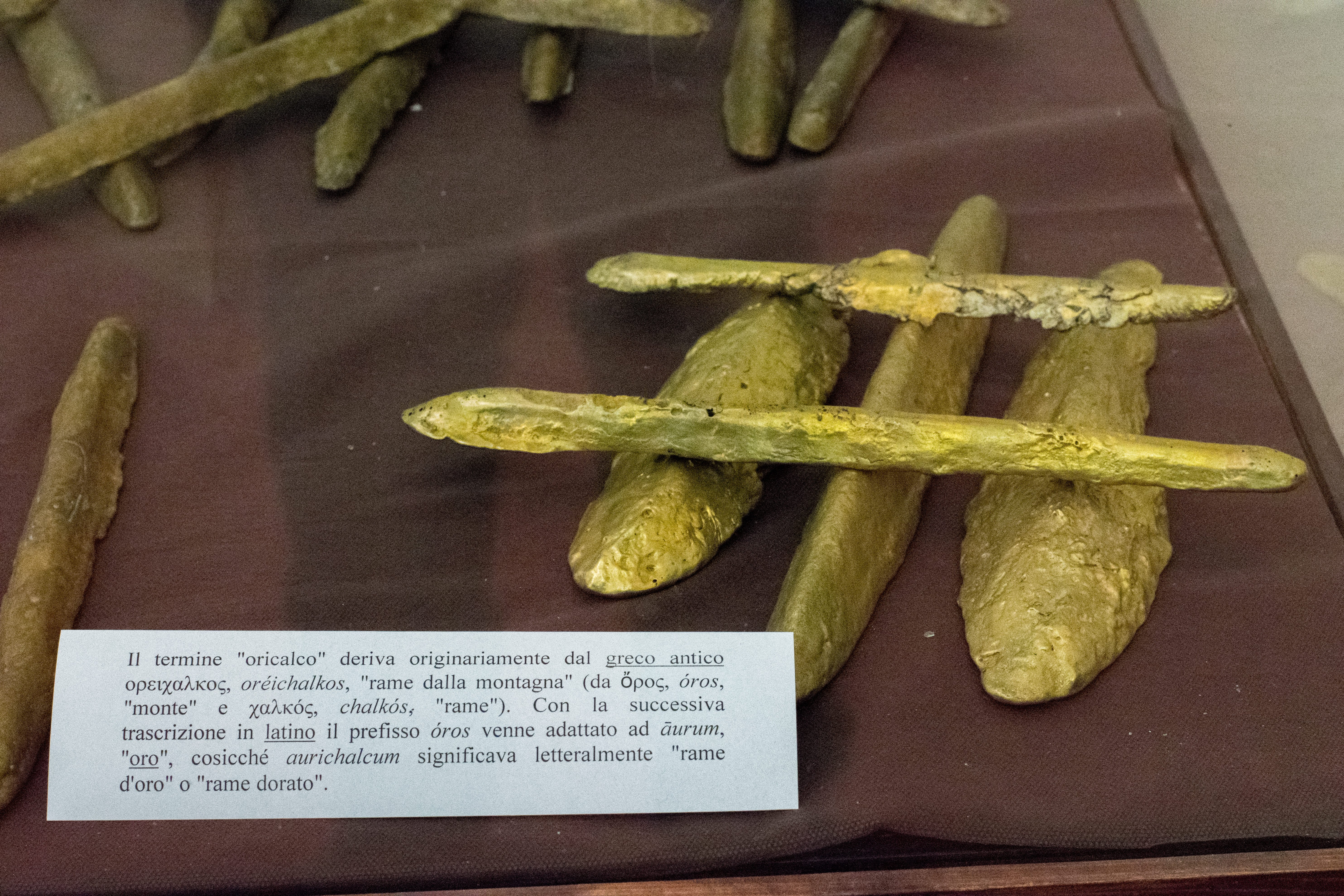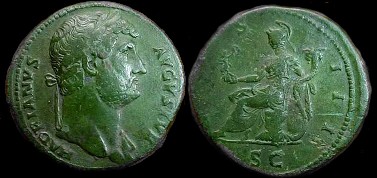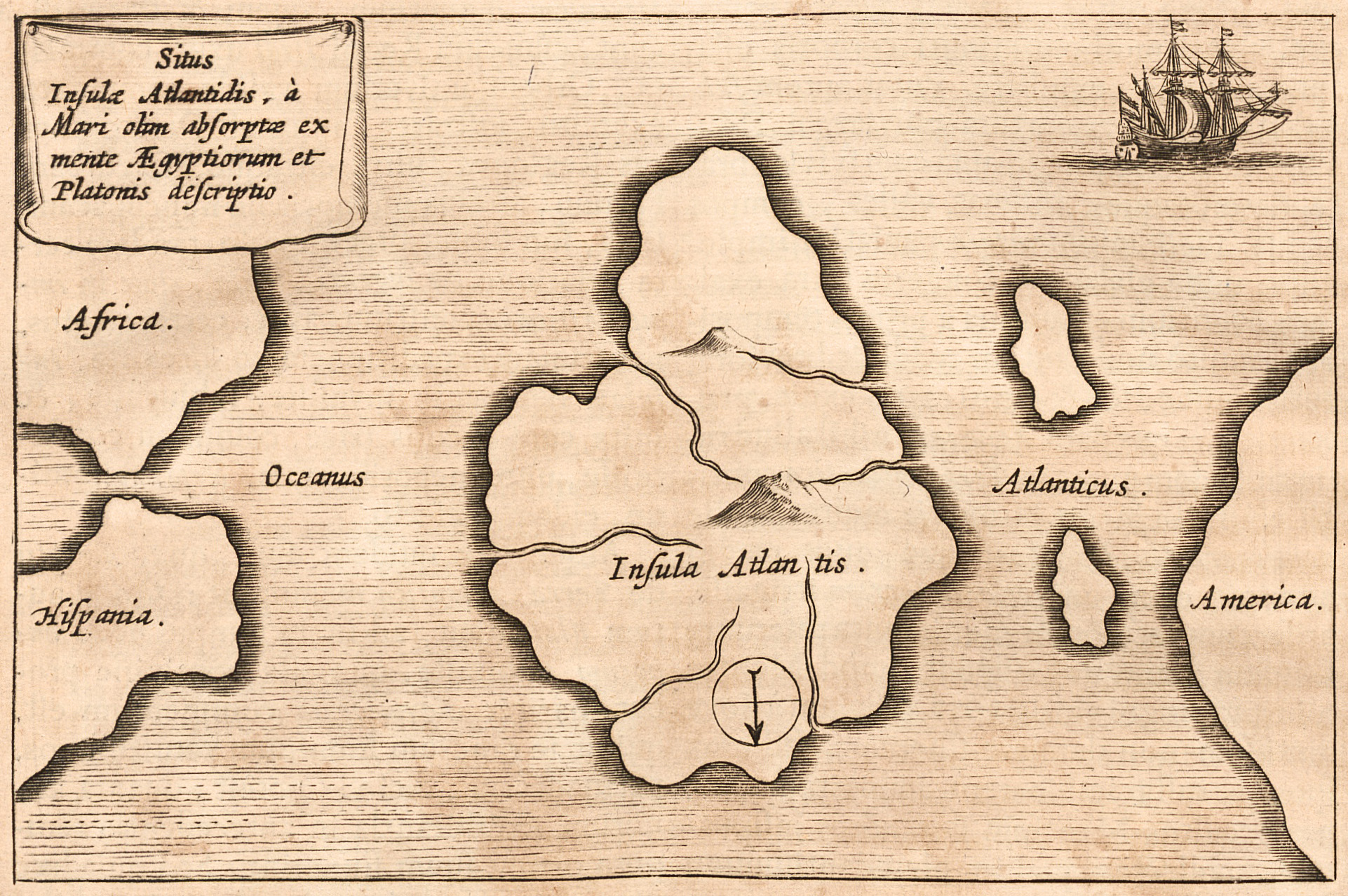|
Orichalcum
Orichalcum (or aurichalcum) or orichalc is a metal mentioned in several ancient writings, including the story of Atlantis in the ''Critias'' of Plato. Within the dialogue, Critias (460–403 BC) says that orichalcum had been considered second only to gold in value and had been found and mined in many parts of Atlantis in ancient times, but that by Critias's own time, orichalcum was known only by name. Orichalcum may have been a noble metal such as platinum, as it was supposed to be mined, but has been identified as pure copper or certain alloys of bronze, and especially brass alloys in the case of antique Roman coins, the latter being of "similar appearance to modern brass" according to scientific research. Overview The name is derived from the Greek , ' (from , ', mountain and , ', copper), literally meaning "mountain copper". The Romans transliterated "orichalcum" as "aurichalcum", which was thought to mean literally "gold copper". It is known from the writings of Cicer ... [...More Info...] [...Related Items...] OR: [Wikipedia] [Google] [Baidu] |
Brass
Brass is an alloy of copper and zinc, in proportions which can be varied to achieve different colours and mechanical, electrical, acoustic and chemical properties, but copper typically has the larger proportion, generally copper and zinc. In use since prehistoric times, it is a substitutional alloy: atoms of the two constituents may replace each other within the same crystal structure. Brass is similar to bronze, a copper alloy that contains tin instead of zinc. Both bronze and brass may include small proportions of a range of other Chemical element, elements including arsenic, lead, phosphorus, aluminium, manganese and silicon. Historically, the distinction between the two alloys has been less consistent and clear, and increasingly museums use the more general term "list of copper alloys, copper alloy". Brass has long been a popular material for its bright gold-like appearance and is still used for drawer pulls and door handle, doorknobs. It has also been widely used to ma ... [...More Info...] [...Related Items...] OR: [Wikipedia] [Google] [Baidu] |
Sestertius
The ''sestertius'' (: ''sestertii'') or sesterce (: sesterces) was an Ancient Rome, ancient Roman Roman currency, coin. During the Roman Republic it was a small, silver coin issued only on rare occasions. During the Roman Empire it was a large brass coin. The name ''sestertius'' means "two and one half", referring to its nominal value of two and a half ''as (Roman coin), asses'' (a bronze Roman coin, singular ''as''), a value that was useful for commerce because it was one quarter of a denarius, a coin worth ten ''asses''. The name is derived from ''semis'', "half" and ''tertius'', "third", in which "third" refers to the third ''as'': the sestertius was worth two full ''asses'' and half of a third. English-language sources routinely use the original Latin form ''sestertius'', plural ''sestertii''; but older literature frequently uses ''sesterce'', plural ''sesterces'', ''terce'' being the English equivalent of ''tertius''. A modern shorthand for values in sestertii is IIS (Un ... [...More Info...] [...Related Items...] OR: [Wikipedia] [Google] [Baidu] |
Gela
Gela (Sicilian and ; ) is a city and (municipality) in the regional autonomy, Autonomous Region of Sicily, Italy; in terms of area and population, it is the largest municipality on the southern coast of Sicily. Gela is part of the Province of Caltanissetta and is one of the few in Italy with a population and area that exceed those of Caltanissetta, the provincial capital.Gela was founded in 698 BC by Greek colonists from Rhodes and Crete; it was an influential ''polis'' of Magna Graecia in the 7th and 6th centuries BC and became one of the most powerful cities until the 5th c. BC. Aeschylus, the famous playwright, lived here and died in 456 BC. In 1943, during the Allied invasion of Sicily, Invasion of Sicily, the Allies of World War II, Allied forces made their first landing on the island at Gela.La Monte, John L. & Lewis, Winston B. ''The Sicilian Campaign, 10 July17 August 1943'' (1993) United States Government Printing Office pp.56-96 History Ancient era Archaeol ... [...More Info...] [...Related Items...] OR: [Wikipedia] [Google] [Baidu] |
Atlantis
Atlantis () is a fictional island mentioned in Plato's works '' Timaeus'' and ''Critias'' as part of an allegory on the hubris of nations. In the story, Atlantis is described as a naval empire that ruled all Western parts of the known world, making it the literary counter-image of the Achaemenid Empire. After an ill-fated attempt to conquer "Ancient Athens," Atlantis falls out of favor with the deities and submerges into the Atlantic Ocean. Since Plato describes Athens as resembling his ideal state in the ''Republic'', the Atlantis story is meant to bear witness to the superiority of his concept of a state. Despite its minor importance in Plato's work, the Atlantis story has had a considerable impact on literature. The allegorical aspect of Atlantis was taken up in utopian works of several Renaissance writers, such as Francis Bacon's ''New Atlantis'' and Thomas More's ''Utopia''. On the other hand, nineteenth-century amateur scholars misinterpreted Plato's narrative as histo ... [...More Info...] [...Related Items...] OR: [Wikipedia] [Google] [Baidu] |
Critias (dialogue)
''Critias'' (; ), one of Plato's late dialogues, recounts the story of the mighty island kingdom Atlantis and its attempt to conquer Athens, which failed due to the ordered society of the Athenians. ''Critias'' is the second of a projected trilogy of dialogues, preceded by '' Timaeus'' and followed by '' Hermocrates''. The latter was possibly never written and the ending to ''Critias'' has been lost. Because of their resemblance (e.g., in terms of persons appearing), modern classicists occasionally combine both ''Timaeus'' and ''Critias'' as ''Timaeus-Critias''. Protagonists * Timaeus Unlike the other speakers of the ''Critias'', it is unclear whether Timaeus is a historical figure or not. While some classicists regard him as definitively historical, others guess that "Plato's picture of him has probably borrowed traits from various quarters". Frank assumes Archytas of Tarentum to be the person which Timaeus is partly based on. On the other hand, F. M. Cornford strongly oppo ... [...More Info...] [...Related Items...] OR: [Wikipedia] [Google] [Baidu] |
ICP-OES
Inductively coupled plasma atomic emission spectroscopy (ICP-AES), also referred to as inductively coupled plasma optical emission spectroscopy (ICP-OES), is an analytical technique used for the detection of chemical elements. It is a type of emission spectroscopy that uses the inductively coupled plasma to produce excited atoms and ions that emit electromagnetic radiation at wavelengths characteristic of a particular element. The plasma is a high temperature source of ionised source gas (often argon). The plasma is sustained and maintained by inductive coupling from electrical coils at megahertz frequencies. The source temperature is in the range from 6000 to 10,000 K. The intensity of the emissions from various wavelengths of light are proportional to the concentrations of the elements within the sample. Mechanism The ICP-AES is composed of two parts: the ICP and the optical spectrometer. The ICP torch consists of 3 concentric quartz glass tubes. The output or "work" coil of t ... [...More Info...] [...Related Items...] OR: [Wikipedia] [Google] [Baidu] |
Archaeology Magazine
''Archaeology'' is a bimonthly magazine for the general public, published by the Archaeological Institute of America. The institute also publishes the professional ''American Journal of Archaeology The ''American Journal of Archaeology'' (AJA), the peer-reviewed journal of the Archaeological Institute of America, has been published since 1897 (continuing the ''American Journal of Archaeology and of the History of the Fine Arts'' founded by t ....'' Its first issue was published in the spring of 1948. The editor-in-chief was Peter Young until 2011 when he was replaced by Claudia Valentino. Jarrett A. Lobell assumed the editorship from Valentino in November 2018. References External links * Science and technology magazines published in the United States Archaeology magazines Magazines established in 1948 Bimonthly magazines published in the United States Magazines published in New York City {{archaeology-mag-stub ... [...More Info...] [...Related Items...] OR: [Wikipedia] [Google] [Baidu] |
X-ray Fluorescence
X-ray fluorescence (XRF) is the emission of characteristic "secondary" (or fluorescent) X-rays from a material that has been excited by being bombarded with high-energy X-rays or gamma rays. The phenomenon is widely used for elemental analysis and analytical chemistry, chemical analysis, particularly in the investigation of metals, glass, ceramics and building materials, and for research in geochemistry, forensic science, archaeology and art objects such as paintings. Underlying physics When materials are exposed to short-wavelength X-rays or to gamma rays, ionization of their component atoms may take place. Ionization consists of the ejection of one or more electrons from the atom, and may occur if the atom is exposed to radiation with an energy greater than its ionization energy. X-rays and gamma rays can be energetic enough to expel tightly held electrons from the inner atomic orbital, orbitals of the atom. The removal of an electron in this way makes the electronic structu ... [...More Info...] [...Related Items...] OR: [Wikipedia] [Google] [Baidu] |
1st Century BC
The 1st century Before Christ, BC, also known as the last century BC and the last century Common Era , BCE, started on the first day of 100 BC, 100 BC and ended on the last day of 1 BC, 1 BC. The Anno Domini, AD/BC notation does not use a year zero; however, astronomical year numbering does use a zero, as well as a minus sign, so "2 BC" is equal to "year –1". 1st century AD (Anno Domini) follows. In the course of the century, all the remaining independent lands surrounding the Mediterranean Sea were steadily brought under Roman control, being ruled either directly under governors or through Puppet monarch, puppet kings appointed by Rome. The Roman state itself was plunged into civil war several times, finally resulting in the marginalization of its 500-year-old Roman Republic, and the embodiment of total state power in a single man—the Roman emperor. The internal turbulence that plagued Rome at this time can be seen as the death throes of the Roman Rep ... [...More Info...] [...Related Items...] OR: [Wikipedia] [Google] [Baidu] |
Alloy
An alloy is a mixture of chemical elements of which in most cases at least one is a metal, metallic element, although it is also sometimes used for mixtures of elements; herein only metallic alloys are described. Metallic alloys often have properties that differ from those of the pure elements from which they are made. The vast majority of metals used for commercial purposes are alloyed to improve their properties or behavior, such as increased strength, hardness or corrosion resistance. Metals may also be alloyed to reduce their overall cost, for instance alloys of gold and Copper(II) sulfate, copper. A typical example of an alloy is SAE 304 stainless steel, 304 grade stainless steel which is commonly used for kitchen utensils, pans, knives and forks. Sometime also known as 18/8, it as an alloy consisting broadly of 74% iron, 18% chromium and 8% nickel. The chromium and nickel alloying elements add strength and hardness to the majority iron element, but their main function is ... [...More Info...] [...Related Items...] OR: [Wikipedia] [Google] [Baidu] |
Cambridge University Press
Cambridge University Press was the university press of the University of Cambridge. Granted a letters patent by King Henry VIII in 1534, it was the oldest university press in the world. Cambridge University Press merged with Cambridge Assessment to form Cambridge University Press and Assessment under Queen Elizabeth II's approval in August 2021. With a global sales presence, publishing hubs, and offices in more than 40 countries, it published over 50,000 titles by authors from over 100 countries. Its publications include more than 420 academic journals, monographs, reference works, school and university textbooks, and English language teaching and learning publications. It also published Bibles, runs a bookshop in Cambridge, sells through Amazon, and has a conference venues business in Cambridge at the Pitt Building and the Sir Geoffrey Cass Sports and Social Centre. It also served as the King's Printer. Cambridge University Press, as part of the University of Cambridge, was a ... [...More Info...] [...Related Items...] OR: [Wikipedia] [Google] [Baidu] |







